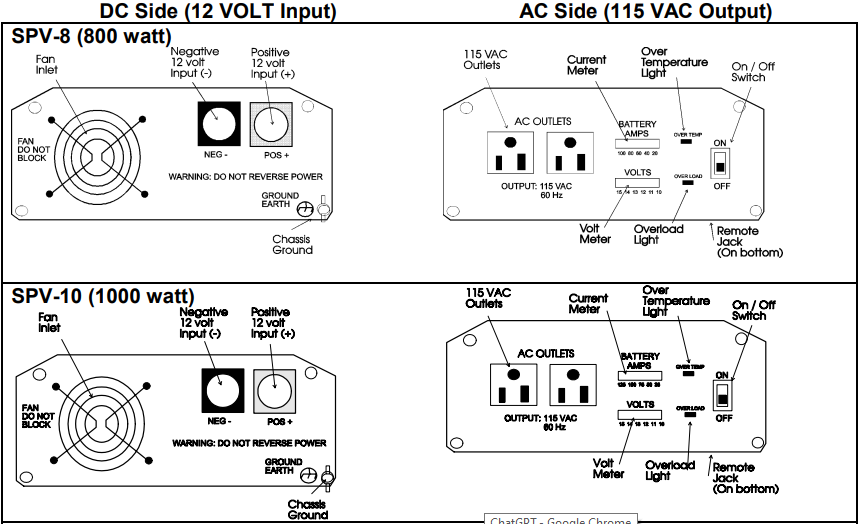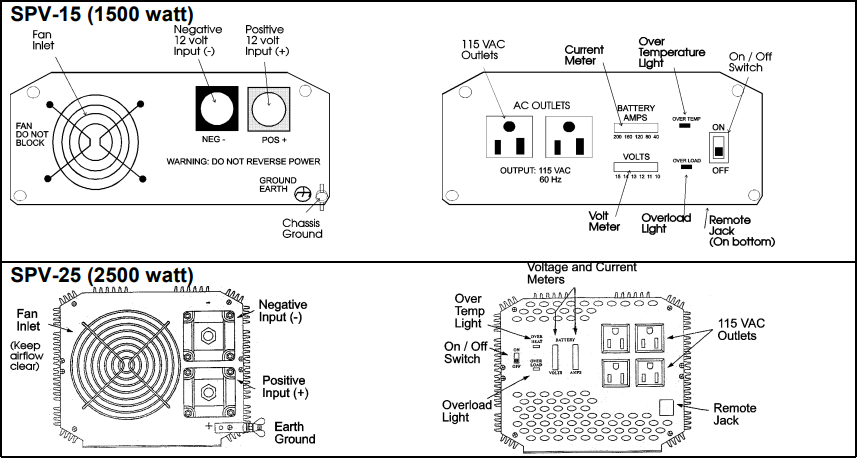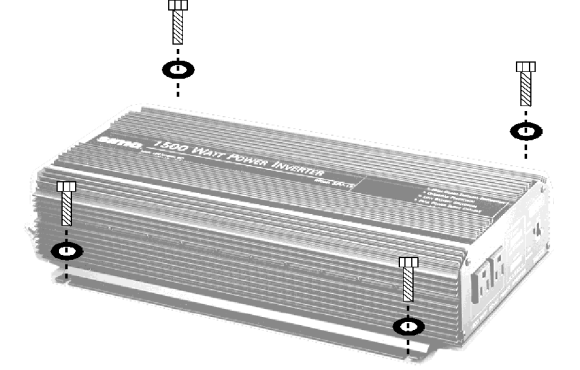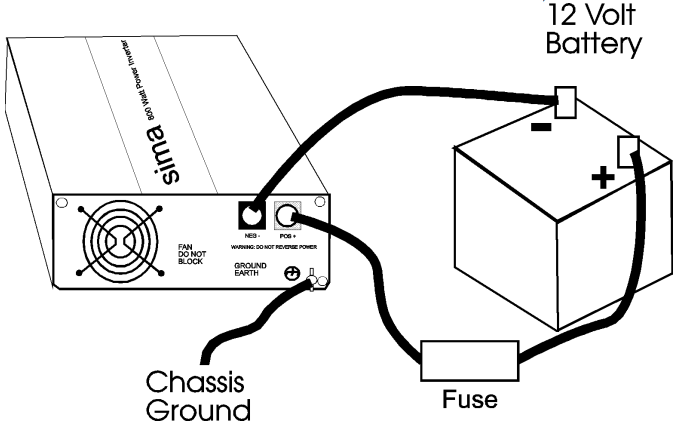Sima 2500 Watt Power Inverters SPV-25 User Guide | Operations & Installation

Content
Introduction of SIMA 2500 Watt Power Inverters SPV-25
The SIMA 2500 Watt Power Inverter SPV-25 is a versatile and robust solution for your power needs, designed to provide clean and stable AC power from a DC source. Ideal for powering appliances during road trips, camping, or as a backup power source in case of outages, this inverter offers a max output of 2500W with a surge capacity of 5000W. Expect it to hit the market in the coming months with an estimated price range of $300 to $350.
Congratulations on your purchase of a Sima power inverter. It provides 115 VAC anywhere you have 12 volts DC in your car, truck, RV or boat. It is designed to be easy to use and to provide years of dependable service.
Package Includes
- Inverter (SPV-8, SPV-10, SPV-15 or SPV-25)
- 5’ Cables with Alligator clips (except SPV-25)
This manual Needed for Installation (not included)
Mounting hardware for the inverter 12 volt dc power wiring, fuse block and connectors Tools
SIMA Detailed Specifications
- Continuous Power: 2500W
- Surge Power: 5000W
- Output Voltage: 120V AC
- Input Voltage: 12V DC
- Conversion Efficiency: 90%
- Protection: Overload, Overvoltage, Undervoltage, and Short Circuit
- Cooling System: Forced Air
- Weight: 11.5 lbs (5.2 kg)
- Dimensions: 14.2 x 6.7 x 3.4 in (36 x 17 x 8.6 cm)
KEY FEATURES | SPV-8 | SPV-10 | SPV-15 | SPV-25 |
Input | 12 - 14 volts DC | 12 - 14 volts DC | 12 - 14 volts DC | 12 - 14 volts DC |
Input no-load current | < 0.55A | < 0.6A | < 0.6A | < 0.95A |
Output type | modified sine wave | modified sine wave | modified sine wave | modified sine wave |
Output, Watts, | ||||
20 minutes | 800W | 1,000W | 1,500W | 2,500W |
continuous | 650W | 800W | 1,200W | 2,000W |
10 minutes | 900W | 1,100W | 1,650W | 2,750W |
Output, peak | 1,600W | 2,000W | 3,000W | 5,000W |
Frequency, +/- 1% | 60 Hz | 60 Hz | 60 Hz | 60 Hz |
Outlets | 2 | 2 | 2 | 4 |
Volt meter | yes | yes | yes | yes |
Current meter | yes | yes | yes | yes |
Remote turn on capability | yes | yes | yes | yes |
Protection | ||||
Thermal | yes | yes | yes | yes |
Low battery alarm Low battery shutdown Output short circuit | yes, 10.5v yes, 10v yes | yes, 10.5v yes, 10v yes | yes, 10.5v yes, 10v yes | yes, 10.5v yes, 10v yes |
Size (inches) | 3” x 10” x 13” | 3” x 10” x 15” | 3” x 10” x 17” | 6.5” x 9.5” x 19” |
Weight: unit/gross | 6.2 / 10 lb | 7.1 / 11 lb | 8.6 / 12 lb | 20 / 24 lb |
Package Includes: User Manual Alligator cables |
yes yes (5’) |
yes yes (5’) |
yes yes (5’) |
yes no |
Overview of the Power Inverter
The Sima power inverter is an electronic device that converts the low voltage 12 volt from a battery or other power source to 115 VAC to run standard household appliances. (See the section on How it Works to learn more about the technology used in the Sima power inverter.)
Key Features of SIMA 2500 Watt Power Inverters SPV-25
High-efficiency operation to provide the most output with the least battery power usage.
Advanced protection
- Thermal Protection shuts the unit off to guard against the unit getting too hot
- Overload Protection protects the unit from excessive loads
- Under Voltage Protection turns the unit off to protect the battery from being over discharged
The Sima power inverter produces a modified sine wave output which is suitable for most AC loads. This includes lights, appliances, motors, TVs and most electronics.
CAUTION: There are a few battery chargers that are not compatible with modified sine wave operation. These are typically small rechargeable, battery operated devices like razors and flashlights that can be plugged directly into an AC receptacle to recharge. Some chargers for battery packs used in power tools also should not be used with an inverter. These chargers typically have a warning label indicating that dangerous voltages are present at the battery terminals. Only a true sine wave inverter should be used with these types of appliances. Damage to the device could result if you attempt to use them with any type of modified sine wave inverter.
Do not use the Sima power inverter with the above devices.
Installation


Installation Overview
There are three basic steps you need to follow when installing the power inverter.
- Mounting: Mount the inverter securely
- Wiring: Wire the inverter to a 12 volt source
- Testing: Test for proper operation
Mounting the Inverter

- The power inverter should be secured to a solid flat surface capable of handling the weight of the unit. It is very important that the unit be secured using the proper sized mounting hardware (not included) to keep the unit from moving around or becoming loose in emergency situations.
- The power inverter should be placed with space around the unit for proper ventilation. Do not block the air entrance to the fan or block the exhaust holes located on the side or bottom of the unit.
- The unit must be mounted in a dry, cool area. Do not allow water to drip or splash onto the inverter. The ambient air temperature should be between 32° F and 75° F.
- The unit must not be mounted in an area with batteries or in any area capable of storing flammable liquids such as gasoline.
- To minimize cable lengths, the unit should be mounted as close as possible to the battery, but not in the same compartment. If you have a choice, it is better to run longer AC wires than DC cables.
CAUTION: The power inverter must be mounted securely in any type of moving vehicle. In an emergency situation, if the power inverter is not securely mounted, it could cause bodily injury
Wiring Inverter to 12 Volt Power
The power inverter requires connection to a standard 12 volt DC power source as found in most cars, trucks, RVs and boats. The power source must provide between 11 and 15 volts DC. The power source must be able to provide sufficient current to power the load. See the chart below that shows minimal wire sizing and current draw at full load.
Always connect the positive, red (+) terminal to the positive connection and the negative, black (-) terminal to the negative or ground side of the power system.
Inverter Model | Current at rated power | Suggested UserInstalled 12v Fuse Size | Suggested Wire gauge, less than-10’ | Suggested Wiregauge, 10’ to 25’ |
SPV-8 | 75 Amps | 80 A | 4 AWG | 2 AWG |
SPV-10 | 94 Amps | 100A | 2 AWG or two 6 AWG | 0 AWG or two 4 AWG |
SPV-15 | 140 Amps | 150 A | 2 AWG or two 6 AWG | 1/0 AWG or two 2 AWG |
SPV-25 | 235 Amps | 250 A | 2/0 AWG or two 1 AWG | 4/0 AWG or two 2/0AWG |
Always connect the positive, red (+) terminal to the positive connection and the negative, black (-) terminal to the negative or ground side of the power system.
WARNING: Failure to connect the correct polarity may cause damage to the power inverter and/or your electrical system and is not covered by the warranty.
SIMA 2500 Watt Power Inverters SPV-25 Temporary Wiring
- The power inverter (except the SPV-25 because of the high current draw) comes with a set of jumper cables to attach directly to your battery terminals for temporary usage. For permanent installation, you should hardwire the power inverter into your 12 volt system as described below.
WARNING: When connecting cables, a spark may occur. This is normal. To prevent explosion from the battery gasses, when connecting jumper cables, always connect the wires to the inverter first, then connect the positive alligator clip to the positive (+) terminal on the battery. Finally connect the negative (-) alligator clip to a solid ground point on the engine. - Connect the red wire to the red positive (+) terminal on the inverter and the black wire to the black negative (-) terminal on the inverter. Connect the red alligator clip to the positive battery terminal and the black alligator to the frame or engine of the vehicle. Follow the instructions below and proceed to Step #3 Testing the Power Inverter.
INSTALLATION TIP
To minimize electrical interference, keep the DC power cables as short as possible and twist them with 1 to 3 twists per foot. This minimizes radiated interference from the cables.
Permanent Installation

CAUTION: Always use adequate wire size and fusing for any installation
Wiring Steps
- Disconnect the positive battery terminal before doing any wiring to the inverter.
- Using proper sized copper wire and proper terminations, wire the inverter to the electrical system and fuse block. See your local RV dealer or automotive shop for wire, connectors, fuse block and other wiring parts. Tighten all connections firmly, but do not over tighten. Remember to recheck all connections every few months of operation.
- SPV-8, SPV-10 and SPV-15 - Strip ½” of insulation off of the wire and insert into the terminal on the inverter. Do not tin the wire. Tighten the set screw securely using a proper size screwdriver
- SPV-25 - Use ring type lugs for a 5/16” post to attach to the wires. Crimp the lugs to the wire and slide the lugs under the nut and tighten securely.
- Connect the GROUND terminal to earth or chassis ground using at least a # 8 wire. It is recommended to crimp a ring type terminal to the ground wire and attach it to the ground lug.
WARNING: Do not operate the inverter without the ground connection. Electrical shock hazard could result. - Double check all wiring for proper polarity and there are no frayed wires.
- Install the fuse and reconnect the wire to the battery. Note, a slight spark and beep from the inverter is normal when the unit is first connected to 12 volt power.
Operation of SIMA 2500 Watt Power Inverters SPV-25
Equipment Power Usage
It is important to use only products that draw less than the power rating of the power inverter. Use of products greater than the rated power rating may either cause the protection circuitry of the power inverter to shut down or the fuse to blow. Repeated use of excessive power draw can cause failure of the power inverter.
How to calculate power usage. Most products have a power rating on them such as 45 watts. Others may be marked with their current draw, such as .9 amps. To convert the current to watts multiply the current by 115. (Example: .9 amps x 115 = 104 watts)
Typical Power Usage Chart
Typical Appliance | Typical Appliance current Draw |
Cellular phone charger | 20 watts |
Camcorder | 30 watts |
VCR | 45 watts |
Soldering iron | 45 watts |
Laptopcomputer | 70 watts |
13” TV | 70 watts |
19” TV | 95 watts |
100watt work light | 100 watts |
Smallstereo system | 120 watts |
3/8” drill | 500 watts |
Smallmicrowave oven | 1,100 watts |
Hair dryer | 1,200watts |
Largemicrowave oven | 1,700 watts |
Circular saw | 1,800 watts |
Some products draw a high surge current to start up. If the appliance does not operate and the inverter turns off, you may need a larger inverter. Also, check that the 12 volt wiring to the inverter is large enough to handle the current draw and that the battery is fully charged.
IMPORTANT: The smaller power inverters may not operate some appliances designed to produce heat such as hair dryers, heaters, toasters and coffee makers. Always check the power rating before using these kinds of products to be sure they do not exceed the power capability of the inverter.
Battery Life
Important: The power inverter can draw lots of amps from your car’s battery when operating. If you are using it for extended periods of time, you will want to operate your car occasionally to maintain the charge in your car’s battery. In addition, the power inverter will also draw a small current, less than 0.1 amp, when turned off and not operating. Therefore, it should be disconnected from your car’s battery if your vehicle will not be used for more than a day. The following chart shows typical operation time for two typical car batteries with the engine not running for various loads. Check the size of your battery.
Battery Life Chart
Power Usage | Approximate 12v Current | Typical operation time with 50 amp- hour car battery | Typical operation timewith 100 amp- hour car battery |
100 watt | 9 Amps | 5.5 hours | 11 hours |
200 watt | 19 Amps | 2.6 hours | 5.2 hours |
500 watt | 47 Amps | 1 hour | 2 hours |
1,000 watt | 94 Amps | 30 minutes | 1 hour |
1,500 watt | 140 Amps | 20 minutes | 40 minutes |
2,500 watt | 235 Amps | 12 minutes | 24 minutes |
Actual Current Draw
Approximate 12 volt current draw is the load in watts divided by 10. Therefore, a 60 watt light bulb plugged into the inverter will cause the inverter to draw 6 amps (60 / 10 = 6) from the 12 volt supply.
Batteries are rated in several different ways
- Peak cranking amps
This has little to do with how long an inverter can supply power, so it is not a useful number for inverter operation. - Battery reserve capacity
This number shows how long a battery can supply a given current, typically 25 amps, before the battery voltage reaches a low voltage. Therefore a battery rated at 200 minutes reserve can deliver 25 amps for 200 minutes before it is discharged. - Ampere-hour capacity
This rating indicates how many amps a battery can deliver over a period of time, typically 20 hours. Therefor a 100 amp-hour battery can deliver 5 amps for 20 hours (5 x 20 = 100). - Actual operating time from a battery will depend upon the current draw from the battery. A battery will deliver less total power (energy) as you draw higher amps. A 100 amp-hour battery can deliver 5 amps for 20 hours (100 amp-hours), but it will only deliver 50 amps for 1 ½ hours (50 x 1.5 = 75) or 75 amp-hours at the higher rate. Also remember, battery life is decreased if the battery is discharged fully. Lead-acid batteries have the longest life, if they are kept fully charged.
How the Inverter Works
The Sima power inverter has two electronic sections. The first section converts 12 volts DC to approximately 160 volts DC using modern high frequency conversion techniques that uses small lightweight efficient transformers. The second section converts the 160 volts DC to 115 VAC using high efficiency power MOSFET transistor devices. The inverters generate a modified sine wave that works with almost every product on the market.
CAUTION: Do not use the following products with an inverter with a modified sine wave output.
- Small battery operated devices like razors, flashlights and night lights that can be plugged directly into an AC outlet to
- A few battery chargers for power tool battery packs that have warnings about high voltage present on the battery terminals.
SIMA 2500 Watt Power Inverters SPV-25 Description
The SIMA SPV-25 is a modified sine wave inverter, suitable for powering most household appliances, tools, and electronic devices. Its durable ABS housing ensures long-lasting performance, even in harsh environments. The inverter features a user-friendly LED display for monitoring power usage and diagnostics. With multiple outlets (two GFCI AC outlets and one USB port), the SIMA SPV-25 is a convenient and reliable power source for various applications.
Setup Guide
- Connect the inverter to a 12V DC power source, such as a deep-cycle battery or a vehicle's battery.
- Turn on the power source and the inverter.
- Plug your devices into the inverter's AC outlets or the USB port.
- Monitor the LED display to ensure proper operation and safe usage.
Troubleshooting of Inverters SPV-25
Problem | Cause | Solution |
Unit does not operate | Input voltage is below 11 volts | Attach to proper supply. Charge batteries. |
Fuse blown | Determine causefor fuse blowing and then replace fuse feeding inverter. | |
Fan doesnot run but unit operates | Normal when unit is cool | |
Unit operates for a short period and then turns off | Load is trying to draw too much current | Be sure load is less thanrated watts of inverter. Remove excessive load. Turn inverter off and back on to reset. |
Unit operates for a while and gets hot | Inverter is in thermal shutdown mode | Allow inverter to cool downand it will resetautomatically. |
VOLTS meter indicates 10.5 volts and alarm is on | Input voltageis below 10.5 volts | Make sure car engineis running. Check condition of wiring. Battery maybe low and needs recharging. |
Television andstereo interference | RF interference from power inverter | Position the power inverter and wiring as far as possible from electronic equipment, antenna and cables and reorient as necessary. |
115 VACOutput voltage reads incorrectly | Modified sine wave output can cause incorrect reading on a typical multimeter | Use a true RMS meter like a Fluke 8060A or Triplett 4200 to measure correct voltage. |
Light Status Chart
Power Switc h |
Voltage Meter | OVER TEMP Light | OVER LOAD Light |
Beeper |
Fan* |
Mode |
Off | Off | Off | Off | Off | Off | Unitis off |
On | 11 to 13 volts | Off | Off | Off | On* | Normal Operation |
On | Greater than 14.5 volts | Off | Off | On | On* | High inputvoltage, above 14 volts |
On | 10 to 10.5 volts | Off | Off | On | On* | Low inputvoltage, 10.5 to 10.0 volts |
On | Less than 10.5 volts | Off | Off | On | On* | Low inputvoltage, less than 10 volts |
On | Off | On | Off | On | On | Unitover temperature |
On | Off | Off | On | Off | Off | Unitoverloaded |
On | Off | Off | Off | Off | Off | No 12 VOLT input to inverter |
SIMA 2500 Watt Power Warranty
Sima Products Corp. (“Company”) warrants that if the accompanying product proves to be defective to the original purchaser in material or workmanship within 90 days from the original retail purchase, the Company will, at the Company’s option, either repair or replace same without charge (but no cash refund will be made).
Pros & Cons
Pros
- High power output and surge capacity
- Durable and lightweight design
- Multiple outlets and a user-friendly display
- Protection features for safe operation
Cons
- Modified sine wave output may not be suitable for all sensitive electronics
- Some users may prefer a pure sine wave inverter for specific applications
Customer Reviews about SIMA 2500 Watt Power Inverters SPV-25
Users have praised the SIMA SPV-25 for its solid build quality, high power output, and value for money. Some common complaints include the inverter generating noticeable noise during operation and the fan occasionally producing excessive heat.
Faqs
What is the difference between a modified sine wave and a SIMA 2500 Watt Power Inverters SPV-25?
How do I properly set up the SIMA 2500 Watt Power Inverters SPV-25 for the first time?
How long can the SIMA 2500 Watt Power Inverters SPV-25 run a 1500W load?
How can I connect the SIMA 2500 Watt Power Inverters SPV-25 to my vehicle’s battery?
Can I connect multiple batteries to the SIMA 2500 Watt Power Inverters SPV-25 to extend its run time?
Where is the ideal location to install the SIMA 2500 Watt Power Inverters SPV-25?
What should I do if the SIMA 2500 Watt Power Inverters SPV-25 emits a burning smell?
Can I use the SIMA 2500 Watt Power Inverters SPV-25 in my RV?
What precautions should I take when operating the SIMA 2500 Watt Power Inverters SPV-25 in cold weather?
How do I know when to replace the fuses in the SIMA 2500 Watt Power Inverters SPV-25?
Leave a Comment
